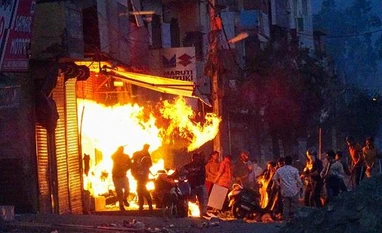Raisina Hill chose to stand inert when a disqualified Aam Aadmi Party (AAP) MLA-turned Bharatiya Janata Party tough issued an “ultimatum” to the Delhi Police to clear the roads of peaceful protestors against the Citizenship Amendment Act (CAA) or face the consequences after Mr Trump’s visit. The fact that this incendiary statement was made in the presence of a senior police official is noteworthy: Clearly, Kapil Mishra felt a measure of impunity for triggering the rioting that preceded his timetable. He remains at large and continues to tweet defiantly pointing to extraordinary forbearance by a police force that swiftly arrested students at the Jawaharlal Nehru University on the slimmest of pretexts under sedition laws. The law courts have defined sedition as a crime that provokes just the kind of law and order problem that Mr Mishra precipitated.
Equally, Home Minister Amit Shah has much to answer for. He would have been well aware of the febrile and stubborn nature of the CAA protests from Shaheen Bagh, which he targeted unsuccessfully during the Delhi Assembly election campaign. He did well by skipping Mr Trump’s Rashtrapati Bhavan reception to manage the situation in north-east Delhi, but TV images relayed the conspicuous absence of the police or outright collusion with rowdies on occasion. Even then Mr Shah did not think it necessary to call in the military or paramilitary forces, which have a sufficiently large presence around the capital to be mobilised at short notice. It is certainly bizarre that the high court had to be mobilised — in the middle of the night — to order the police to organise the transport of injured people to better-equipped hospitals and restore law and order, in short to do its job. The media briefing from the government on Wednesday did not help. The environment minister launched into a tirade against the Congress (for the 1984 anti-Sikh riots) and admonished the press for “demoralising” the police. And the appeal from Prime Minister Narendra Modi to restore normalcy came a bit late in the day.
Arguments over whether anti-CAA protestors, AAP members or freelance defenders of the Hindu faith were responsible for the rioting are beside the point. Blame-gaming is a popular political ruse but the time for it has passed. It is urgent that the emergency meeting of the Cabinet looks for ways to lower the political temperature, restore law and order, and prove that the government functions for all Indians, not just those who profess its majoritarian beliefs.
To read the full story, Subscribe Now at just Rs 249 a month
Already a subscriber? Log in
Subscribe To BS Premium
₹249
Renews automatically
₹1699₹1999
Opt for auto renewal and save Rs. 300 Renews automatically
₹1999
What you get on BS Premium?
-
Unlock 30+ premium stories daily hand-picked by our editors, across devices on browser and app.
-
Pick your 5 favourite companies, get a daily email with all news updates on them.
Full access to our intuitive epaper - clip, save, share articles from any device; newspaper archives from 2006.
Preferential invites to Business Standard events.
Curated newsletters on markets, personal finance, policy & politics, start-ups, technology, and more.
Need More Information - write to us at assist@bsmail.in
)